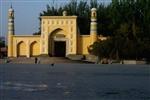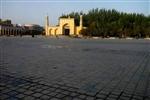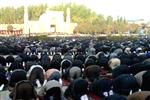- Getting around Lijiang. Dont stay in the Old Towns more than 2 days, there is nothing to do. KRISS Oct 9, 2013 05:46
- 2013 Beijing Temple Fair BENNYLAU Feb 26, 2013 03:29
- Malaysian traveling from KUL - LAX vis Shanghai PVG ZATI_DY Jan 3, 2013 20:15
Kashgar: The Id Kah Mosque
- Views: 6033
- |Vote: 0 0
- |Add to Favorites
- |Recommend to Friends
Located in the heart of Kashgar, a city on the western tip of Xinjiang inhabited mostly by Islamic Uyghurs is a mosque that by many standards might be considered small yet is well-known as the largest mosque in China. The Islamic art is easily distinguishable among the drab shopping centers which surround it and its yellow tiles give it a color to mirror the desert in which it lies. At first glance it might be hard for any person who has traveled to see Europe’s grand cathedrals to be impressed by this small structure, but there is much more to be seen than one may realize.
In order to fully appreciate this mosque, as with most any destination you travel to see, you must first understand a bit of its history. Officially this mosque was built in 1442 as a prayer hall by the ruler of Kashgar at the time, Saqsiz Mirza, for the purpose of saying prayers for the souls of his deceased relatives. Before this time, however, part of this plot of land was used as a cemetery while the rest was dotted with older structures that can be dated back to 996 AD.
Its construction also lies within the reign of Ming Dynasty Emperor Zhengtong (1435-1464), during a time when Xinjiang wasn’t yet a part of China and the dynasty was caught up in a fierce struggle with the Mongols. Kashgar, too, was struggling with its own set of battles between tribes yet restored a small degree of calm and stability between the 14th and 15th centuries allowing for the construction of the prayer hall. In 1538 the prayer hall was expanded into a community center of worship and since that time has undergone numerous renovations and expansions in the 16th, 18th, and 19th centuries to become what we now see today.
Currently the Id Kah mosque, sometimes referred to as Aytga, covers a total area of 16,800 square meters. The yellow building seen in most pictures is merely the gateway to a large, open-air courtyard that measures 140 meters by 120 meters and houses the prayer hall, a teaching hall, a pond and other smaller structures. On a normal Friday the mosque is said to hold 10,000 worshippers while during major festivals close to 20,000 can be crammed inside. Located to the west of the mosque, in front of the yellow gate tower, is an open plaza which, when filled with prayer mats, can be occupied by another twenty or thirty thousand people.
It was this plaza which was the site of a rise in tension between the Uyghurs and the Han Chinese in 2003 when a large garden which used to sit in front of the mosque was drastically shrunk to make way for an underground market. There isn’t much information available about this conflict, but pictures of the mosque with its large rose garden before 2003 can still be bought on the street, and the underground shopping center can be accessed from nearby. The extra space provided by the reconstruction actually comes in handy during the big festivals when masses of people converge on the mosque.
As mentioned before, the mosque itself isn’t that impressive. For a small admission fee you can stroll around the courtyard, enter the prayer hall, admire the Uyghur architecture, and hope you don’t catch a disease from the filthy pond. Unless you have an incredibly deep appreciation for Muslim customs or Uyghur wood carving you’ll probably find yourself in and out in less than 20 minutes wondering why you wanted to enter in the first place. Every picture you ever see taken of the mosque is of the outside. There’s a reason for that.
Thankfully there’s a redeeming factor to this mosque that is based upon the time of year you arrive. If you come to visit this area during one of the two major Islamic festivals, Eid al-Adha (called “Corban” in China) or Eid ul-Fitr (simply called “Eid”), you’ll find yourself in the middle of an experience you’ll never forget. Because these two festivals are observed on the Islamic calendar, their dates change from year to year so it’s important to check before arriving. During these two festivals the faithful from all over Xinjiang and a few other bordering countries to the west flock to this mosque and fill the area with more prayer mats than you would need to cover a football field and more square hats than necessary to give to each fan.
In the early morning hours of either Eid, any person who wishes to observe the call to prayer must rise before the sun to find a good place to take pictures. Obviously the location of choice would be a tall building or shopping mall, but most of these places are closed down for the holiday. For hours before the call begins, men in their best clothing can be seen quietly walking from every direction to fill the mosque, endlessly moving through the gate that never seems to get full. No women are allowed, but many can be seen across the street repeating the prayers and waiting for the celebration to begin.
Around 9am Beijing time, the call begins and the men prepare. It truly is a sight to see – tens of thousands of men in unison taking off their shoes, laying their mats, and doing all of it without uttering a word. Men in the mosque, men in the plaza, men in the streets, and men in the side streets calmly stand up, kneel, repeat prayers, and listen as the imam gives a small sermon and recites the prayers. Even if the mosque itself isn’t that impressive, it’s hard not to be wowed by the number of people who gather here and the calming way in which they gather.
Once prayer ends make sure you are nowhere near an exit because there are a lot of people around and they’re all leaving at the same time. They may be leaving, but it’s not yet over. If you’re patient enough to hang around for maybe an hour you’ll get to see the most popular method for an Islamic Uyghur to celebrate holiday – dancing! Musicians sitting on top of the gate tower provide the beat for large groups of dancers to move their feet, and once they begin it’s hard for them to stop. Hours upon hours are spent moving to the music until the time comes to eat and celebrate with family and friends.
All of this – the dancing, the prayers, the food, the music – are a small window into the soul of this Uyghur people, a must-see for anybody interested in their culture, and all of it occurs in or nearby this mosque. One would be remiss to say that the Id Kah Mosque is merely located in the heart of Kashgar. It is, in fact, the true heart of the city.
Tips for Travelers and Prices
1) If you want to see the call to prayer, arrive early in the morning to find a good spot. You’ll see many people on top of nearby buildings to take good pictures, but in order to get up there you either need to “know somebody” or slip some money to the guard at the stairs. Pictures from the ground floor, as you can see above, can be just as incredible and are absolutely free.
2) Women are allowed to watch the proceedings, and although a head cover is recommended, it is not completely necessary. You’ll see plenty of ladies roaming the streets without them.
3) This should go without saying, but it is imperative that you respect the culture. No loud noises, talking, or laughing, and it is considered very rude to stand in front of a person performing the prayer ritual. Pictures and video cameras are both permitted.
4) Take a tour of the mosque before you see the festival event. You’ll get a better understanding of what’s going on inside. Since a full tour inside is what I consider a waste of money, just walk in, look around, and walk back out.
Prices:
Entrance into the Id Kah Mosque: 30 RMB per person.
Digital camera: 500 – 20,000 RMB depending on quality and model
Pictures of thirty to forty thousand people celebrating Eid: Priceless.









 Copyright © 1998-2026 All rights reserved.
Copyright © 1998-2026 All rights reserved.
1.
Oct 2, 2010 05:06 Reply
CHUBBYCHOPS said:
Thank you very much for this beautifully written piece. We have just returned from Kashgar and did not go into the Id Kah Mosque, so your article made us feel better about honoring our hunches. The price was 20 RMB, as of October 2010....a bit steep for a place of prayer. Seems it has become a place of money grabbing. We were relieved to read your review.